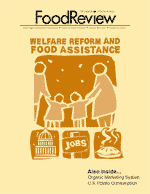|
FoodReview: Welfare Reform and Food Assistance, Vol. 24, No. 1
By Rosanna Mentzer Morrison, Economics Editor
ERS
FoodReview No. 24-1.
July 2001
About this magazine
Published three times a year by the Food and Rural Economics Division, Economic Research Service, U.S. Department of Agriculture, FoodReview informs public and private decisionmakers of the critical economic issues surrounding domestic and foreign food consumption, food prices, food assistance programs, nutrition, food safety, and the impacts of Federal food regulations and policies.
In this report ...
Articles are in Adobe Acrobat PDF format.
Contents, 25 kb
Upfront, 14 kb
Feature Articles
- Strong Economy and Welfare Reforms
Contribute to Drop in Food Stamp Rolls--This article weighs the effects on participation in the Food Stamp Program of a strong economy and changes in welfare programs resulting from the 1996 welfare reform act. ERS research found that 35 percent of the decline in participation from 1994 to 1998 was associated with economic growth, while less than 5 percent appeared to be associated with the 1996 reforms. The second half of the article discusses the economic situations of people leaving the Food Stamp Program.
- Food Stamp Participation
Rate Down in Urban Areas But Not in Rural--Although the Food Stamp Program serves a predominately urban population, nearly 1/4 of food stamp participants live in rural areas. Researchers looking at rural-urban differences in food stamp participation found that the number of food stamp recipients fell 25 percent in urban areas between 1996 and 1998, com-pared with 17 percent in rural areas. Also, the participation rate-the proportion of people eligible for food stamps who participate in the program-declined in urban areas, but not in rural areas.
- Food Stamp Participation
and Food Security--This article looks at the food security situation of food stamp participants and low-income nonparticipants. National survey data on household hunger and food insecurity indicate that the food security of households receiving food stamps was essentially unchanged between 1995 and 1999, with the exception of women food stamp participants living alone. The prevalence of food insecurity for low-income households not receiving food stamps increased from 23 percent in 1995 to 29 percent in 1999. The size of the increase in food insecurity rate indicates that low-income households were less aware of their eligibility for food stamps or found it difficult, or less socially acceptable, to get food stamps in 1999 than in 1995.
- Community Food Security
Programs Improve Food Access--Discusses how community-based efforts such as farmers markets, food cooperatives, community-supported agriculture, farm-to-school initiatives, and community gardens, complement Federal food assistance programs by increasing the quantity, quality, and affordability of food in a community.
- WIC Increases the Nutrient Intake of Children--USDA's Economic Research Service recently examined WIC's effect on the nutrient intake of children participating in the program. The study looked at eight nutrients-protein, calcium, iron, vitamin A, vitamin C, folate, vitamin B-6, and zinc-and food energy. The study found that participation in WIC leads to increased intake of iron, vitamin B-6, and folate.
- Organic Marketing Features Fresh Foods and
Direct Exchange--Industry sources estimate that organic food sales reached $7.8 billion in 2000. Conventional grocery stores began integrating a wider selection of organic products in the late 1990's and now account for 49 percent of total organic sales, about the same as natural food stores (48 percent). Direct markets, such as farmers markets, captured 3 percent of total organic sales to U.S. consumers in 2000.
- Fast Food Growth Boosts Frozen Potato Consumption--The most significant changes in potato consumption over the past several decades have been the rise in frozen potato consumption and the decline of fresh potato consumption. This article looks at consumption patterns for six types of potato products. Food intake surveys show that African Americans consume more potato chips and french fries, on a per capita basis, than other Americans. Seniors favor consumption of fresh and canned potatoes, while teenagers consume more chips and french fries than other age groups. Intake surveys also show regional variations in consumption of potato products.
Entire report, 380 kb
Order this report (stock #ERSFR24-1)
Past Issues pdf format
web administration: webadmin@ers.usda.gov
page updated: July 27, 2001
|
|  |
